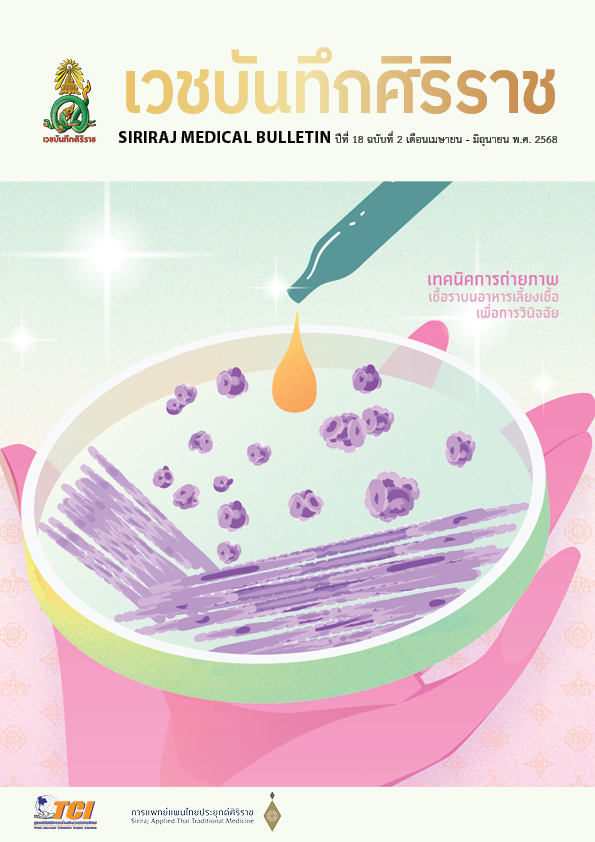Caring for Patients with Aortic Stenosis Undergoing Transcatheter Aortic Valve Implantation (TAVI) in Catheterization Laboratory
Main Article Content
Abstract
Aortic stenosis (AS) is one of the most common types and serious valvular heart disease in elderly people. The most common cause of aortic stenosis in the elderly is the buildup of calcifications on the heart valves, leading to progressive narrowing of the aortic valve orifice and impairing the heart's ability to effectively pump blood to peripheral organs and tissues. Consequently, affected individuals may experience symptoms of reduced cardiac output, such as angina, dyspnea, and syncope. Patients diagnosed with severe aortic stenosis (AS) typically require treatment with Aortic Valve Replacement (AVR) surgery However, many patients have high surgical risk for surgical AVR. Transcatheter Aortic Valve Implantation (TAVI) is used as an alternative to open-heart surgery for patients diagnosed with symptomatic severe aortic stenosis (AS) who are deemed unsuitable candidates for traditional surgical procedures. TAVI requires preparation, expertise, and collaboration among medical professionals such as interventional cardiologists, cardiac surgeons, anesthesiologists, ultrasound physicians, nurses, radiologic technologist, and cardiothoracic technologists. The TAVI team aims to enhance proficiency by incorporating specialized skills and knowledge that could mitigate the negative impacts of therapeutic cardiac interventions. It is crucial to provide attentive care to patients with aortic stenosis undergoing Transcatheter Aortic Valve Implantation (TAVI) in the cardiac catheterization laboratory. Effective management of patients undergoing Transcatheter Aortic Valve Implantation (TAVI) for aortic stenosis in the cardiac catheterization laboratory is essential.
Article Details

This work is licensed under a Creative Commons Attribution-NonCommercial-NoDerivatives 4.0 International License.
References
สุรีย์ เลขวรรณวิจิตร. พยาธิวิทยาของโรคหัวใจ. เชียงใหม่: พิมพ์ครั้งที่ 1 2556, โรงพิมพ์ คณะแพทยศาสตร์ มหาวิทยาลัยเชียงใหม่
ผ่องพรรณ อรุณแสง. การพยาบาลผู้ป่วยโรคหัวใจและหลอดเลือด. ขอนแก่น: พิมพ์ครั้งที่ 8 2554, คลังนานาวิทยา.
Otto CM, Nishimura RA, Bonow RO, et al. 2020 ACC/AHA Guideline for the Management of Patients With Valvular Heart Disease: A Report of the American College of Cardiology/American Heart Association Joint Committee on Clinical Practice Guidelines. Circulation. 2021;143(5):e72-e227.
Mack MJ, Leon MB, Thourani VH, et al. Transcatheter Aortic-Valve Replacement with a Balloon-Expandable Valve in Low-Risk Patients. N Engl J Med. 2019;380(18):1695-1705.
Popma JJ, Deeb GM, Yakubov SJ, et al. Transcatheter Aortic-Valve Replacement with a Self-Expanding Valve in Low-Risk Patients. N Engl J Med. 2019;380(18):1706-1715.
Généreux, P, Sharma, R, Cubeddu, R. et al. The Mortality Burden of Untreated Aortic Stenosis. J Am Coll Cardiol. 2023;82 (22):2101–2109.
Onishi T, Sengoku K, Ichibori Y, et al. The role of echocardiography in transcatheter aortic valve implantation. Cardiovasc Diagn Ther. 2018;8(1):3-17.
Brecker S. Transcatheter aortic valve implantation: periprocedural management. UpToDate. 2018. http://www.uptodate.com.
Corrigendum to: 2021 ESC/EACTS Guidelines for the management of valvular heart disease: Developed by the Task Force for the management of valvular heart disease of the European Society of Cardiology (ESC) and the European Association for Cardio-Thoracic Surgery (EACTS), Eur Heart J. 2021;43(7):561–632.
Sundt TM, Jneid H. Guideline Update on Indications for Transcatheter Aortic Valve Implantation Based on the 2020 American College of Cardiology/American Heart Association Guidelines for Management of Valvular Heart Disease. JAMA Cardiol. 2021;6(9):1088–9.
Arora S, Misenheimer JA, Ramaraj, R. Transcatheter Aortic Valve Replacement: Comprehensive Review and Present Status. Texas Heart Inst J. 2017;44(1):29–38.
Haight K. Caring for patients after transcatheter aortic valve replacement. Am Nurse Today. 2017;12(8):10-16.
Terre JA, George I, Smith CR. Pros and cons of transcatheter aortic valve implantation (TAVI). Ann Cardiothorac Surg. 2017;6(5):444-452.
Galper BZ, Golden J, Rhee J, et al. Implementation of a post-transcatheter valve replacement (TAVR) fast-track care protocol with a focus on next day discharge. J Am Coll Cardiol. 2018;71(11): 10-12.
Roberto S, Giovanni L, Jubin J, et al. Impact of complications during transfemoral transcatheter aortic valve replacement: How can they be avoided and managed? JAHA. 2019;8:e013801.
Rouleau SG, Brady WJ, Koyfman A, Long B. Transcatheter aortic valve replacement complication: A narrative review for emergency clinicians. Am J Emerg Med. 2022;56:77-86.
Khokhar AA, Ruggiero R., Chandra K., et al. Prevention and management of peri-procedural TAVR complications. Mini-Invasive Surg. 2022;6:97.
Mach M, Okutucu S, Kerbel T, et al. Vascular Complications in TAVR: Incidence, Clinical Impact, and Management. J Cli n Med. 20221;10(21):5046.
Schoechlin S, Eichenlaub M, Müller-Edenborn B, et al. Risk Stratification for Pacemaker Implantation after Transcatheter Aortic Valve Implantation in Patients with Right Bundle Branch Block. J Clin Med. 2022;11(19):5580.
Agasthi P, Ashraf H, Pujari SH, et al. Prediction of permanent pacemaker implantation after transcatheter aortic valve replacement: The role of machine learning. World J Cardiol. 2023;15(3):95–105.
Karyofillis P, Kostopoulou A, Thomopoulou S, et al. Conduction abnormalities after transcatheter aortic valve implantation. JGC. 2018;15(1):105–12.





